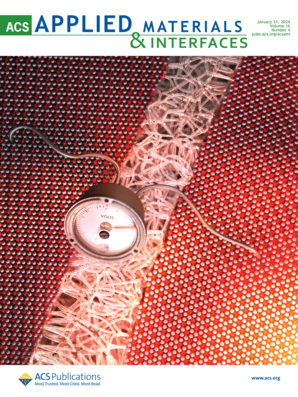高传感灵敏度CPU@MXene@SiO2静电纺丝超疏水柔性可穿戴传感器。
IF 8.3
2区 材料科学
Q1 MATERIALS SCIENCE, MULTIDISCIPLINARY
引用次数: 0
摘要
柔性可穿戴传感器因其在电子皮肤、健康监测和智能设备方面的潜在应用而备受关注。然而,目前的柔性传感器经常受到限制,例如灵敏度低,对机械和化学降解的抵抗力不足。为了解决这些问题,本研究提出了一种CPU@MXene@SiO2超疏水柔性传感器,该传感器采用静电纺丝和浸涂技术相结合的方式制造。该传感器具有由静电纺丝纤维膜(CPU)衬底、MXene导电涂层和超疏水SiO2涂层组成的夹层结构。在此基础上,进一步组装应变传感器和压阻传感器,系统研究微纳结构和化学成分对润湿性和传感性能的影响。实验结果表明,CPU@MXene@SiO2传感器具有高机械强度、超疏水性(CA < 155°,RA < 3°)、低水附着力(33 μN)、高传感灵敏度(测量因子可达4922.6)、快速响应(响应时间为94 ms)等综合性能。此外,为了验证其大规模应用的潜力,设计并开发了一个基于STM32单片机和移动应用程序的完整数据采集系统。成功地制作并测试了一个4 × 4传感器阵列。该传感器在可穿戴设备和人机交互方面具有广阔的应用前景,为构建鲁棒、高灵敏度的柔性传感器提供了一种有效的设计策略。本文章由计算机程序翻译,如有差异,请以英文原文为准。
Electrospinning Superhydrophobic Flexible Wearable Sensor of CPU@MXene@SiO2 with High Sensing Sensitivity.
Flexible wearable sensors have garnered significant attention for their potential applications in electronic skins, health monitoring, and smart devices. However, current flexible sensors often suffer from limitations, such as low sensitivity and inadequate resistance to mechanical and chemical degradation. To address these issues, this study presents a CPU@MXene@SiO2 superhydrophobic flexible sensor fabricated using a combination of electrospinning and dip-coating techniques. This sensor features a sandwich structure composed of an electrospinning fiber membrane (CPU) substrate, an MXene conductive coating, and a superhydrophobic SiO2 coating. Based on the fabricated sensor, strain and piezoresistive sensors were further assembled to systematically investigate the effects of micro/nanostructures and chemical compositions on wettability and sensing performance. Experimental results demonstrated that the CPU@MXene@SiO2 sensor exhibited outstanding comprehensive properties including high mechanical strength, superhydrophobicity (CA > 155°, RA < 3°), low adhesion force (33 μN) with water, high sensing sensitivity (gauge factor up to 4922.6), and fast response (response time of 94 ms). Moreover, to validate its potential for large-scale applications, a complete data acquisition system based on an STM32 microcontroller and a mobile application was designed and developed. A 4 × 4 sensor array was successfully fabricated and tested. This sensor demonstrates promising and attractive applications in wearable devices and human-machine interaction, offering an efficient design strategy for constructing robust and highly sensitive flexible sensors.
求助全文
通过发布文献求助,成功后即可免费获取论文全文。
去求助
来源期刊

ACS Applied Materials & Interfaces
工程技术-材料科学:综合
CiteScore
16.00
自引率
6.30%
发文量
4978
审稿时长
1.8 months
期刊介绍:
ACS Applied Materials & Interfaces is a leading interdisciplinary journal that brings together chemists, engineers, physicists, and biologists to explore the development and utilization of newly-discovered materials and interfacial processes for specific applications. Our journal has experienced remarkable growth since its establishment in 2009, both in terms of the number of articles published and the impact of the research showcased. We are proud to foster a truly global community, with the majority of published articles originating from outside the United States, reflecting the rapid growth of applied research worldwide.
 求助内容:
求助内容: 应助结果提醒方式:
应助结果提醒方式:


